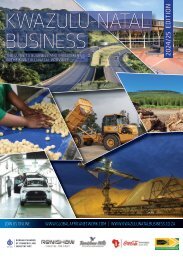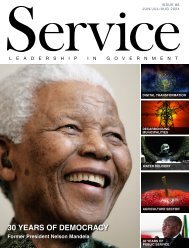Mpumalanga Business 2022-23
The 2022/23 edition of Mpumalanga Business is the 13th issue of this successful publication that since its launch in 2008 has established itself as the premier business and investment guide for the province. With messages of welcome to potential investors from both the provincial premier and the MEC responsible for Economic Development and Tourism, this edition of the journal also contains the official Mpumalanga Investment Prospectus, a comprehensive survey of the province’s assets and the potential of the region. Major catalytic projects such as the Nkomazi Special Economic Zone (NSEZ) and the Mpumalanga International Fresh Produce Market (MIFPM) are examined in detail, outlining how producers, processors and logistics firms stand to benefit and where there is potential for investment. In addition to the Prospectus, the journal contains a special feature on education and a series of brief news briefs about some of the most important sectors in the provincial economy.
The 2022/23 edition of Mpumalanga Business is the 13th issue of this successful publication that since its launch in 2008 has established itself as the premier business and investment guide for the province.
With messages of welcome to potential investors from both the provincial premier and the MEC responsible for Economic Development and Tourism, this edition of the journal also contains the official Mpumalanga Investment Prospectus, a comprehensive survey of the province’s assets and the potential of the region. Major catalytic projects such as the Nkomazi Special Economic Zone (NSEZ) and the Mpumalanga International Fresh Produce Market (MIFPM) are examined in detail, outlining how producers, processors and logistics firms stand to benefit and where there is potential for investment. In addition to the Prospectus, the journal contains a special feature on education and a series of brief news briefs about some of the most important sectors in the provincial economy.
Create successful ePaper yourself
Turn your PDF publications into a flip-book with our unique Google optimized e-Paper software.
Manufacturing<br />
Key components of the incentive programme are<br />
the Manufacturing Incentive Programme (MIP) and<br />
the Manufacturing Competitiveness Enhancement<br />
Programme (MCEP). The initial MCEP, launched in<br />
2012, was so successful that it was oversubscribed<br />
with almost 890 businesses receiving funding.<br />
A second phase of the programme was launched<br />
in 2016. The grants are not handouts as the<br />
funding covers a maximum of 50% of the cost<br />
of the investment, with the remainder to be<br />
sourced elsewhere.<br />
The Enterprise Investment Programme (EIP)<br />
makes targeted grants to stimulate and promote<br />
investment, BEE and employment creation in the<br />
manufacturing and tourism sectors. Aimed at<br />
smaller companies, the maximum grant is R30-<br />
million. Specific tax deductions are permissible for<br />
larger companies investing in the manufacturing<br />
sector under Section 12i of the Income Tax Act.<br />
Other incentives<br />
Other incentives available to investors and existing<br />
businesses in more than one sector include the:<br />
• Technology and Human Resources for Industry<br />
Programme (THRIP)<br />
• Support Programme for Industrial Innovation (SPII)<br />
• Black <strong>Business</strong> Supplier Development Programme<br />
(BBSDP), which is a cost-sharing grant offered to<br />
black-owned small enterprises<br />
• Critical Infrastructure Programme (CIP) that covers<br />
between 10% and 30% of the total development<br />
costs of qualifying infrastructure<br />
• Co-operative Incentive Scheme, which is a<br />
90:10 matching cash grant for registered primary<br />
co-operatives<br />
• Sector Specific Assistance Scheme, which is a<br />
reimbursable 80:20 cost-sharing grant that can be<br />
applied for by export councils, joint action groups<br />
and industry associations.<br />
Incentives for SMMEs<br />
A lot of emphasis is placed on the potential role<br />
of small, medium and micro enterprises in job<br />
creation and a number of incentives are design-<br />
Investments in infrastructure can attract rebates.<br />
The PG Bison Highveld are investing Industrial heavily Park in hosts expanding factories manufacturing<br />
different Gladtidings capacity. Credit: sectors. Interiors PG Bison CC. Image: Seda<br />
ed to promote the growth of these businesses.<br />
These include:<br />
• Small Medium Enterprise Development<br />
Programme (SMEDP)<br />
• Isivande Women’s Fund<br />
• Seda Technology Programme (Stp).<br />
• Seda is the Small Enterprise Development Agency,<br />
an agency of the Department of Small <strong>Business</strong><br />
Development that exists to promote SMMEs.<br />
Trade-related incentives<br />
The Export Marketing and Investment Assistance<br />
(EMIA) Scheme includes support for local<br />
businesses that wish to market their businesses<br />
internationally to potential importers and<br />
investors. The scheme offers financial assistance<br />
to South Africans travelling or exhibiting abroad<br />
as well as for inbound potential buyers of South<br />
African goods. ■<br />
Online Resources<br />
Department of Trade, Industry and Competition:<br />
www.thedtic.gov.za<br />
Industrial Development Corporation:<br />
www.idc.co.za<br />
<strong>Mpumalanga</strong> Economic Growth Agency:<br />
www.mega.gov.za<br />
Official South African government incentive<br />
schemes: www.investmentincentives.co.za<br />
29 11 15 MPUMALANGA BUSINESS <strong>2022</strong>/<strong>23</strong> 2020/21 2021/22


















